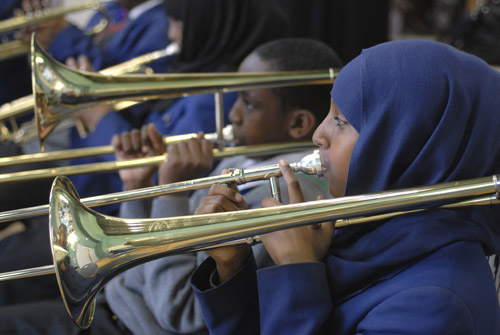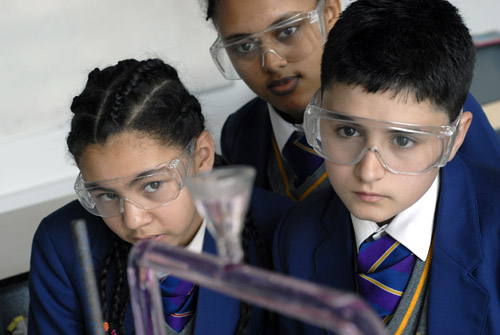We have high expectations for all our pupils and ensure that every learner is challenged and supported to reach their full potential.
Mathematics Curriculum
Introduction
The aim of the Mathematics curriculum is to provide pupils with the critical knowledge and problem solving skills they need to develop their chosen career and lead a successful life. The curriculum also encompasses business and enterprise skills and mathematics that pupils can apply to real life situations. It also equips pupils with skills that can be used across other curriculum areas.
Key Stage 3 Maths
At Key Stage 3, all pupils follow a series of key topics which are then differentiated to suit the needs of the pupils. The KS3 curriculum has been designed to ensure pupils explore topics and reasoning within mathematics to a greater depth to ensure they are prepared for KS4.
Autumn 1: Place value, addition and subtraction
- Place value (including decimals)
- Add and subtract (inc. decimals)
- Estimation
- Perimeter
Autumn 2: Place value, multiplication and division
- Factors, HCF, multiples, LCM
- Multiply and divide (including decimals)
- Area of rectangle and triangle
- Calculate the mean
Spring 1: Geometry: 2D shape in a 3D world
- Draw, measure and name acute and obtuse angles
- Find unknown angles (straight lines, at a point, vertically opposite)
- Properties of triangles and quadrilaterals
Spring 2: Fractions
- Equivalent fractions
- Compare and order fractions and decimals
- Change mixed numbers to improper fractions and vice vers
- Fraction of a quantity
- Multiply and divide fractions
Summer 1: Applications of algebra
- Order of operations
- Substitution
- Simplify algebraic expressions
- Solve word problems with expressions
- Sequences (term-to-term, not nth term)
Summer 2: Percentages and pie charts
- Construct and interpret statistical diagrams including pie charts
- Convert between percentages, vulgar fractions and decimals
- Percentage of a quantity
- Find the whole given the part and the percentage
Autumn 1: Number
- Primes and indices
- Prime factorisation to find LCM, HCF, squares, cubes
- Venn diagrams
- Enumerating sets
- Add and subtract fractions
Autumn 2: Algebraic expressions
- Negative numbers and inequality statements
- Formulate and evaluate expressions
- Linear equations
- Expressions and equations from real-world situations
- Linear sequences: nth term
Spring 1: 2-D geometry
- Draw accurate triangles and quadrilaterals (ruler, protractor, compasses)
- Find unknown angles (including parallel lines)
- Conversion between length units and between area units
- Areas and perimeters of composite figures
- Areas of parallelograms and trapeziums
Spring 2: Proportional reasoning
- Convert between percentages, vulgar fractions and decimals
- Percentage increase and decrease, finding the whole given the part and the percentage
- Ratio (equivalent, of a quantity) and rate, (4d) Speed, distance, time
Summer 1: 3-D geometry
- Rounding, significant figures and estimation
- Circumference and area of a circle
- Visualise and identify 3-D shapes and their nets
- Volume of cuboid, prism, cylinder, composite solids
Summer 2: Statistics
- Collect and organise data
- Interpret and compare statistical representations
- Mean, median and mode averages, (6d) The range and outliers
Key Stage 4 Maths
At Key Stage 4, all pupils at Platanos College follow the curriculum outlined below. It is the case that pupils will cover a range of topics which span both the foundation and higher specifications.
In Year 9, pupils begin the GCSE course and the KS4 curriculum builds on KS3 content. It is challenging and the complexity is designed to ensure pupils are exploring a range of reasoning and problem-solving questions.
In Year 10, pupils continue with the GCSE course. The curriculum builds on many topics introduced in Year 9.
In Year 11, pupils have exposure to higher level topics and they will also review key aspects of the GCSE specification.
Number
- Calculations
- Decimal numbers
- Place value
- Factors and multiples
- Squares, cubes and roots
- Index notation
- Prime factors
Algebra
- Algebraic expressions
- Simplifying expressions
- Substitution
- Formulae
- Expanding brackets
- Factorising
- Using expressions and formulae
Graphs, tables and charts
- Frequency tables
- Two-way tables
- Representing data
- Time series
- Stem and leaf diagrams
- Pie charts
- Scatter graphs
- Line of best fit
Fractions and percentages
- Working with fractions
- Operations with fractions
- Multiplying fractions
- Dividing fractions
- Fractions and decimals
- Fractions and percentages
- Calculating percentages
- Calculating percentages 2Equations, inequalities and sequences
- Solving equations 1
- Solving equations 2
- Solving equations with brackets
- Introducing inequalities
- More inequalities
- More formulae
- Generating sequences
- Using the nth term of a sequence
Angles
- Properties of shapes
- Angles in parallel lines
- Angles in triangles
- Exterior and interior angles
- More exterior and interior angles
- Geometrical patterns
Averages and range
- Mean and range
- Mode, median and range
- Types of average
- Estimating the mean
- Sampling
Perimeter, area and volume 1
- Rectangles, parallelograms and triangles
- Trapezia and changing units
- Area of compound shapes
- Surface area of 3D solids
- Volume of prisms, 8.6 More volume and surface area
Number
- Number problems and reasoning
- Place value and estimating
- HCF and LCM
- Calculating with powers (indices)
- Zero, negative and fractional indices
- Powers of 10 and standard form
- Surds
Algebra
- Algebraic indices
- Expanding and factorising
- Equations
- Formulae
- Linear sequences
- Non-linear sequences
- More expanding and factorising
Interpreting and representing data
- Statistical diagrams
- Time series
- Scatter graphs
- Line of best fit
- Averages and range
- Statistical diagrams 2
Fractions, ratio and percentages
- Fractions
- Ratios
- Ratio and proportion
- Percentages
- Fractions, decimals and percentages
Angles and trigonometry
- Angle properties of triangles and quadrilaterals
- Interior angles of a polygon,
- Exterior angles of a polygon
- Pythagoras’ theorem
- Pythagoras’ theorem 2,
- Trigonometry 1
- Trigonometry 2
Graphs
- Linear graphs
- More linear graphs
- Graphing rates of change
- Real-life graphs
- Line segments
- Quadratic graphs
- Cubic and reciprocal graphs
- More graphs Area and volume
- Perimeter and area
- Units and accuracy
- Prisms
- Circles
- Sectors of circles
- Cylinders and spheres
- Pyramids and cones
Graphs
- Coordinates
- Linear graphs
- Gradient
- y = mx + c
- Real-life graphs
- Distance-time graphs
- More real-life graphs
Transformations
- Translation
- Reflection
- Rotation
- Enlargement
- Describing enlargements
- Combining transformations
Ratio and proportion
- Writing ratios
- Using ratios
- Ratios and measures
- Using ratios 2
- Comparing using ratios
- Using proportion
- Proportion and graphs
- Proportion problems
Right-angled triangles
- Pythagoras’ theorem 1
- Pythagoras’ theorem 2
- Trigonometry: the sine ratio 1
- Trigonometry: the sine ratio 2
- Trigonometry: the cosine ratio
- Trigonometry: the tangent ratio
- Finding lengths and angles using trigonometry
Probability
- Calculating probability
- Two events
- Experimental probability
- Venn diagrams
- Tree diagrams
- More tree diagrams
Multiplicative reasoning
- Percentages
- Growth and decay
- Compound measures
- Distance, speed and time
- Direct and inverse proportion
Constructions, loci and bearings
- 3D solids
- Plans and elevations
- Accurate drawings 1
- Scale drawings and maps
- Accurate drawings 2
- Constructions
- Loci and regions
- Bearings
Quadratic equations and graphs
- Expanding double brackets
- Plotting quadratic graphs
- Using quadratic graphs
- Factorising quadratic expressions
- Solving quadratic equations algebraically
Perimeter, area and volume 2
- Circumference of a circle 1
- Circumference of a circle 2
- Area of a circle
- Semicircles and sectors
- Composite 2D shapes and cylinders
- Pyramids and cones
- Spheres and composite solids
Transformations and constructions
- 3D solids
- Reflection and rotation
- Enlargement
- Transformations and combinations of transformations
- Bearings and scale drawings
- Constructions 1
- Constructions 2
- Loci
Equations and inequalities
- Solving quadratic equations 1
- Solving quadratic equations 2
- Completing the square
- Solving simple simultaneous equations
- More simultaneous equations
- Solving linear and quadratic simultaneous equations
- Solving linear inequalities
Probability
- Combined events
- Mutually exclusive events
- Experimental probability
- Independent events and tree diagrams
- Conditional probability
- Venn diagrams and set notation
Multiplicative reasoning
- Growth and decay
- Compound measures
- More compound measures
- Ratio and proportion
Similarity and congruence
- Congruence
- Geometric proof and congruence
- Similarity
- More similarity
- Similarity in 3D solids
More trigonometry
- Accuracy
- Graph of the sine function
- Graph of the cosine function
- The tangent function
- Calculating areas and the sine rule
- The cosine rule and 2D trigonometric problems
- Solving problems in 3D
- Transforming trigonometric graphs 1
- Transforming trigonometric graphs 2
Further statistics
- Sampling
- Cumulative frequency
- Box plots
- Drawing histograms
- Interpreting histograms
- Comparing and describing populations
Fractions, indices and standard form
- Multiplying and dividing fractions
- The laws of indices
- Writing large numbers in standard form
- Writing small numbers in standard form
- Calculating with standard form
Congruence, similarity and vectors
- Similarity and enlargement
- More similarity
- Using similarity
- Congruence 1
- Congruence 2
- Vectors 1
- Vectors 2
More algebra
- Graphs of cubic and reciprocal functions
- Non-linear graphs
- Solving simultaneous equations graphically
- Solving simultaneous equations algebraically
- Rearranging formulae
- Proof
Equations and graphs
- Solving simultaneous equations graphically
- Representing inequalities graphically
- Graphs of quadratic functions
- Solving quadratic equations graphically,
- Graphs of cubic functions
Circle theorems
- Radii and chords
- Tangents
- Angles in circles 1
- Angles in circles 2
- Applying circle theorems
More algebra
- Rearranging formulae
- Algebraic fractions
- Simplifying algebraic fractions
- More algebraic fractions
- Surds
- Solving algebraic fraction equations
- Functions
- Proof
Vectors and geometric proof
- Vectors and geometric proof
- Vector arithmetic
- More vector arithmetic
- Parallel vectors and collinear points
- Solving geometric problems
Proportion and graphs
- Direct proportion
- More direct proportion
- Inverse proportion
- Exponential functions
- Non-linear graphs
- Translating graphs of functions
- Reflecting and stretching graphs of functions
Free standing maths qualifications
In addition to GCSE Mathematics, the highest attaining pupils are offered the opportunity to gain qualifications in Further Maths (a level 2 qualification) or Additional Maths (a level 3 qualification).
- Numbers and the number system
- Manipulating algebraic expressions
- Graphs of functions
- Linear and quadratic equations
- Algebraic proof
- Co-ordinate geometry
- Pythagoras’ theorem
- Trigonometric functions
- Trigonometrical identities
- Calculus
- Matrices
- Algebraic manipulation
- Polynomials, functions and equations
- Applications of equations and inequalities
- Sequences and recurrence of relationships
- Coordinate geometry
- Trigonometric functions
- Applications of trigonometry
- Permutations and combinations
- The binomial distribution
- Exponentials and logarithms
- Numerical methods
- Differentiation
- Integration
- Application to kinematics




